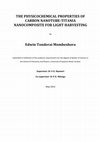Papers by Edwin Mombeshora
Journal of Energy Storage

Discover Materials, Dec 16, 2023
For sustainability motives, the world must accelerate current work towards meeting the rising ene... more For sustainability motives, the world must accelerate current work towards meeting the rising energy demands whilst reducing the current huge dependency on fossil energy resources. Fossil fuels contaminate the environment, cause health-related complications to humankind and are finite. Renewables are promising in countering these adversities. However, renewable energy resources have sporadic characteristics, thus, need effective energy storage systems for clean energy transition. One such energy storage system with the potential to grow towards large-scale commercialisation is the supercapacitor (SC). Current research foci in SCs include improved capacitance, lifespan, stability, energy and power densities through the development of effective and highly stable electrode materials. One typical and promising electrode material is the conducting polymer (CP). However, CPs still face some drawbacks; such as ion depletions, mechanical issues, operational stability and short-term stability; to develop further. Hence, compositing CPs with carbonaceous materials, namely graphene derivatives, is among the current suitable strategies to counter these setbacks. Henceforth, the current work reviews the impact of graphene derivatives as additives to CP-based SCs regarding tuneable band gap, nontoxicity, lightweight, remarkable flexibility, low costs emanating from abundant sources, facile synthesis methods and easy scalability. The review also provides recommendations for future directions to enhance the sustainability of both CPs and SCs. The discussed literature outlines that graphene derivative additives to polymers has phenomenal potential to achieve long-term stability and highly performing SCs through synergism.

Renewable Energy Focus, Jun 1, 2023
Half-Heusler phases (space group F43m, C1 b) have recently captured much attention as promising t... more Half-Heusler phases (space group F43m, C1 b) have recently captured much attention as promising thermoelectric materials for heat-to-electric power conversion in the mid-to-high temperature range. The most studied ones are the RNiSn-type half-Heusler compounds, where R represents refractory metals Hf, Zr, and Ti. These compounds have shown a high-power factor and high-power density, as well as good material stability and scalability. Due to their high thermal conductivity, however, the dimensionless figure of merit (zT) of these materials has stagnated near 1 for a long time. Since 2013, the verifiable zT of half-Heusler compounds has risen from 1 to near 1.5 for both n-and p-type compounds in the temperature range of 500-900 • C. In this brief review, we summarize recent advances as well as approaches in achieving the high zT reported. In particular, we discuss the less-exploited strain-relief effect and dopant resonant state effect studied by the author and his collaborators in more detail. Finally, we point out directions for further development.

RSC Advances, 2023
Technological advancements are leading to an upsurge in demand for functional materials that sati... more Technological advancements are leading to an upsurge in demand for functional materials that satisfy several of humankind's needs. In addition to this, the current global drive is to develop materials with high efficacy in intended applications whilst practising green chemistry principles to ensure sustainability. Carbon-based materials, such as reduced graphene oxide (RGO), in particular, can possibly meet this criterion because they can be derived from waste biomass (a renewable material), possibly synthesised at low temperatures without the use of hazardous chemicals, and are biodegradable (owing to their organic nature), among other characteristics. Additionally, RGO as a carbon-based material is gaining momentum in several applications due to its lightweight, nontoxicity, excellent flexibility, tuneable band gap (from reduction), higher electrical conductivity (relative to graphene oxide, GO), low cost (owing to the natural abundance of carbon), and potentially facile and scalable synthesis protocols. Despite these attributes, the possible structures of RGO are still numerous with notable critical variations and the synthesis procedures have been dynamic. Herein, we summarize the highlights from the historical breakthroughs in understanding the structure of RGO (from the perspective of GO) and the recent stateof-the-art synthesis protocols, covering the period from 2020 to 2023. These are key aspects in the realisation of the full potential of RGO materials through the tailoring of physicochemical properties and reproducibility. The reviewed work highlights the merits and prospects of the physicochemical properties of RGO toward achieving sustainable, environmentally friendly, low-cost, and high-performing materials at a large scale for use in functional devices/processes to pave the way for commercialisation. This can drive the sustainability and commercial viability aspects of RGO as a material.
Journal of Materials Science: Materials in Electronics
Applied Surface Science Advances
New Journal of Chemistry
High-temperature treatment increased the conductivity, carrier density and mobility of N-RGO. Inc... more High-temperature treatment increased the conductivity, carrier density and mobility of N-RGO. Inclusion of PANI tailored activities from capacitive to battery-like and diffusion-controlled.
since 1984 he worked at SSRC, HIAST, CNR, CRF, DCU and UWS. Prof Olabi has supervised postgraduat... more since 1984 he worked at SSRC, HIAST, CNR, CRF, DCU and UWS. Prof Olabi has supervised postgraduate research students (10 M.Eng and 30PhD) to successful completion. Prof Olabi has edited 12 proceedings, and has published more than 135 papers in peer-reviewed international journals and about 135 papers in international conferences, in addition to 30 book chapters. In the last 12 months Prof Olabi has patented 2 innovative projects. Prof Olabi is the founder of the International Conference on Sustainable Energy

List of Abbreviations and Symbols XiX Chapter One Introduction List of Tables Chapter Two 2.1 The... more List of Abbreviations and Symbols XiX Chapter One Introduction List of Tables Chapter Two 2.1 The 2002 WHO statistics for the indoor smoke related disease cases in East African region 2.2 Global and EU renewable electricity energy generation statistics 2.3 Properties of some carbon allotropes 2.4 Selected performance of TiO2-based solar cells 2.5 Some reported titania doping outcomes 2.6 Some reported peaks of TiO2 and MWCNTs in MWCNTs-titania nanocomposites 2.7 Surface areas and pore volumes of some MWCNTs-titania composites 2.8 Effect of iodine concentration on PV performance 2.9 Some reported dyes applied in DSSCs 2.10 Performances of some reported N3 dye-sensitised titania-based solar cells Chapter Three 3.1 ICP-OES instrumental conditions used in titania concentration determination 3.2 Instrumental parameters employed in the MWCNT-titania XRD analysis Chapter Four 4.1 FTIR absorption peaks exhibited by the nanocomposites obtained from both synthetic methods 4.2 Comparison of D and G bands for pristine and acid-treated MWCNTs obtained from the Raman spectroscopy 4.3 The assigned 2 angles for anatase titania and MWCNTs in MWCNT-titania nanocomposites synthesised by the sol-gel and CVD synthetic methods 4.4 Thermal stability temperatures for nanocomposites by the sol-gel and CVD methods 4.5 Comparison of textural characteristics of MWCNT-titania nanocomposites by the sol-gel and CVD synthetic methods 4.6 Titania wt.% loadings for MWCNT-titania nanocomposites synthesised by the sol-gel and CVD methods Chapter Five 5.1 The band gap determination using diffuse reflectance spectroscopy 5.2 The optimisation of iodine concentration for gel state electrolyte synthesis used in DSSCs 5.3 The optimisation of PVAc mass in gel state electrolyte synthesis used in DSSCs 5.4 The light-harvesting performance for the titania synthesised by the sol-gel method at 70 µm using iodine liquid electrolyte 5.5 Light-harvesting performance for the nanocomposites synthesised by the sol-gel and CVD methods at 70 µm using gel state electrolyte 5.6 The MWCNT-titania nanocomposites synthesised by the CVD and sol-gel methods at List of Figures Chapter Two 2.1 The structures of carbon nanotubes 2.2 Position vectors of SWCNTs 2.3 The mechanism involved in the electric generation during light-harnessing 2.4 The thermogravimetric analysis instrument 2.5 The Raman instrument 2.6 The scanning electron microscope 2.7 Diagram of a transmission electron microscopy instrument 2.8 TEM for MWCNT-titania nanocomposites 2.9 XRD instrument 2.10 Typical current density-voltage curve for N3 dye TiO2-based solar cell 2.11 A schematic diagram showing the relationship between potential energy (voltage) and and Fermi level 2.12 The J-V curve for an ideal diode Chapter Three 3.1 A photograph of the MOCVD reactor used in the CVD synthesis of MWCNT-titania nanocomposites 3.2 Photograph of the CVD experimental setup used in the synthesis of the MWCNT-titania nanocomposites 3.3 The images of DSSC components and complete device under characterisation Chapter Four 4.1 Morphology of pristine MWCNTs and MWCNTs treated with a mixture of nitric and hydrochloric acids in the ratio 3:1 in an ultrasonic water bath 4.2 Morphology of MWCNT-titania nanocomposites synthesised by the sol-gel method 4.3 Typical morphology of MWCNT-titania nanocomposites synthesised by the CVD method 4.4 A comparison of the morphology at 1:1 wt.% ratio of MWCNT:titania for the nanocomposites synthesised by the CVD and sol-gel methods 4.5 Representative TEM image for pristine MWCNTs 4.6 A comparison of the outer diameter distribution for pristine and acid-treated MWCNTs 4.7 Representative TEM image for acid-treated MWCNTs showing the resulting roughening of the tube walls 4.8 Representative TEM images for MWCNT-titania nanocomposites synthesised by the solgel method at 5 and 10 wt.% of MWCNTs 4.9 Distribution of MWCNT outer diameters in MWCNT-titania nanocomposites containing 10 wt.% of MWCNTs by both methods and comparison with acid-treated MWCNTs 4.10 Representative TEM image for MWCNT-titania nanocomposites synthesised by the solgel method at 90 and 80 wt.% of MWCNTs 4.11 A comparison of the MWCNT outer diameter distribution for MWCNT-titania nanocomposites at 90 wt.% of MWCNTs by the sol-gel and CVD synthetic methods 4.12 Representative TEM images for MWCNT-titania nanocomposites synthesised by the CVD method at 90 and 80 wt.% of MWCNTs 4.13 Representative TEM images for nanocomposites synthesised by the CVD method at 5 and 10 wt.% of MWCNTs 4.14 Representative HRTEM images at different magnifications for MWCNT-titania nanocomposites containing 5 wt.% of MWCNTs synthesised by the CVD and sol-gel methods E.T. Mombeshora Page xvii 4.15 Typical FTIR spectrum for the MWCNT-titania nanocomposites synthesised either by sol-gel or CVD methods 4.16 Comparison of the ID/IG ratio of the nanocomposites by the sol-gel and CVD synthetic methods 4.17 XRD spectra for MWCNT-titania nanocomposites with high titania wt.% synthesised by CVD method 4.18 Comparison of the TG thermogram for pristine and acid-treated MWCNTs 4.19 Comparison of thermogram for MWCNT-titania nanocomposites synthesised by sol-gel method at high and low MWCNTs wt.% 4.20 Comparison of thermogram for MWCNT-titania nanocomposites by CVD synthetic method at high and low MWCNTs wt.% 4.21 Comparison of the TG thermogram for MWCNT-titania nanocomposites by the CVD and sol-gel synthetic methods at MWCNTs wt.% of 80 and 20 4.22 Representative mapping from the sol-gel and CVD methods and a representative EDX spectrum 4.23 A typical calibration curve for the determination of the titanium concentration in the MWCNT-titania nanocomposites Chapter Five 5.1 A comparison of PL spectra for 2, 20, 40 and 50 wt.% of MWCNTs in MWCNT-titania nanocomposites by the CVD and sol-gel synthetic methods 5.2 The absorbance spectra for eosin B used in DSSCs 5.3 The short circuit current density for nanocomposites synthesised by CVD method I would like to express my sincere gratitude and appreciate special contributions from; My supervisor, Dr V.O. Nyamori for his good supervision skills, advice, guidance and motivation throughout the course of this work.
Energy Science & Engineering
Nanoscale Advances, 2022
Due to the finite nature, health and environmental hazards currently associated with the use of f... more Due to the finite nature, health and environmental hazards currently associated with the use of fossil energy resources, there is a global drive to hasten development and deployment of renewable...

Frontiers in Chemistry
In recent years, carbon-based materials, particularly carbon nanotubes (CNTs), have gained intens... more In recent years, carbon-based materials, particularly carbon nanotubes (CNTs), have gained intensive research attention in the fabrication of organic solar cells (OSCs) due to their outstanding physicochemical properties, low-cost, environmental friendliness and the natural abundance of carbon. In this regard, the low sheet resistance and high optical transmittance of CNTs enables their application as alternative anodes to the widely used indium tin oxide (ITO), which is toxic, expensive and scarce. Also, the synergy between the large specific surface area and high electrical conductivity of CNTs provides both large donor-acceptor interfaces and conductive interpenetrating networks for exciton dissociation and charge carrier transport. Furthermore, the facile tunability of the energy levels of CNTs provides proper energy level alignment between the active layer and electrodes for effective extraction and transportation of charge carriers. In addition, the hydrophobic nature and high...
Materials Chemistry and Physics











Uploads
Papers by Edwin Mombeshora